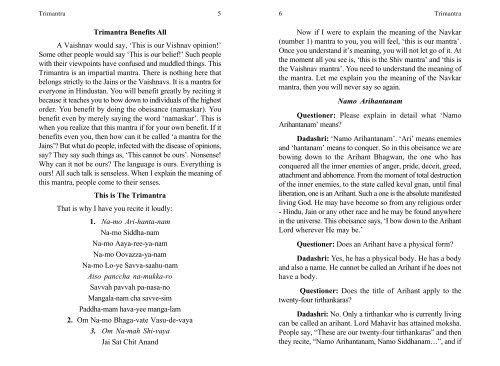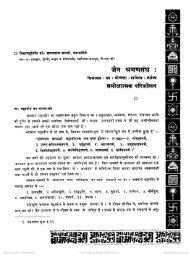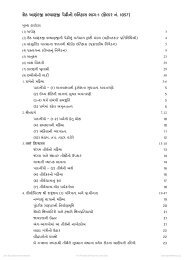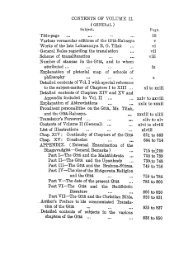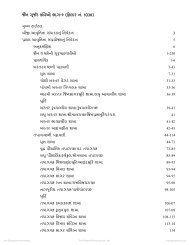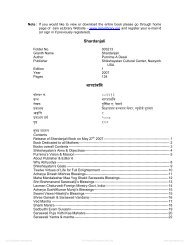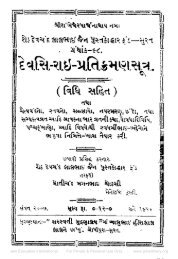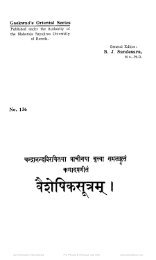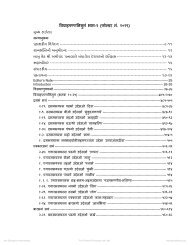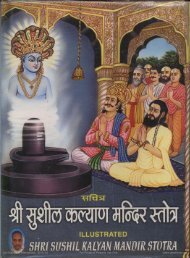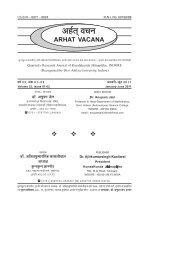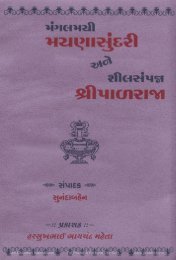You also want an ePaper? Increase the reach of your titles
YUMPU automatically turns print PDFs into web optimized ePapers that Google loves.
Trimantra 5 6 TrimantraTrimantra Benefits AllA Vaishnav would say, ‘This is our Vishnav opinion!’Some other people would say ‘This is our belief!’ Such peoplewith their viewpoints have confused and muddled things. ThisTrimantra is an impartial mantra. There is nothing here thatbelongs strictly to the <strong>Jain</strong>s or the Vaishnavs. It is a mantra foreveryone in Hindustan. You will benefit greatly by reciting itbecause it teaches you to bow down to individuals of the highestorder. You benefit by doing the obeisance (namaskar). Youbenefit even by merely saying the word ‘namaskar’. This iswhen you realize that this mantra if for your own benefit. If itbenefits even you, then how can it be called ‘a mantra for the<strong>Jain</strong>s’? But what do people, infected with the disease of opinions,say? They say such things as, ‘This cannot be ours’. Nonsense!Why can it not be ours? The language is ours. Everything isours! All such talk is senseless. When I explain the meaning ofthis mantra, people come to their senses.This is The TrimantraThat is why I have you recite it loudly:1. Na-mo Ari-hanta-namNa-mo Siddha-namNa-mo Aaya-ree-ya-namNa-mo Oovazza-ya-namNa-mo Lo-ye Savva-saahu-namAiso panccha na-mukka-roSavvah pavvah pa-nasa-noMangala-nam cha savve-simPaddha-mam hava-yee manga-lam2. Om Na-mo Bhaga-vate Vasu-de-vaya3. Om Na-mah Shi-vayaJai Sat Chit AnandNow if I were to explain the meaning of the Navkar(number 1) mantra to you, you will feel, ‘this is our mantra’.Once you understand it’s meaning, you will not let go of it. Atthe moment all you see is, ‘this is the Shiv mantra’ and ‘this isthe Vaishnav mantra’. You need to understand the meaning ofthe mantra. Let me explain you the meaning of the Navkarmantra, then you will never say so again.Namo ArihantanamQuestioner: Please explain in detail what ‘NamoArihantanam’ means?Dadashri: ‘Namo Arihantanam’. ‘Ari’ means enemiesand ‘hantanam’ means to conquer. So in this obeisance we arebowing down to the Arihant Bhagwan, the one who hasconquered all the inner enemies of anger, pride, deceit, greed,attachment and abhorrence. From the moment of total destructionof the inner enemies, to the state called keval gnan, until finalliberation, one is an Arihant. Such a one is the absolute manifestedliving God. He may have become so from any religious order- Hindu, <strong>Jain</strong> or any other race and he may be found anywherein the universe. This obeisance says, ‘I bow down to the ArihantLord wherever He may be.’Questioner: Does an Arihant have a physical form?Dadashri: Yes, he has a physical body. He has a bodyand also a name. He cannot be called an Arihant if he does nothave a body.Questioner: Does the title of Arihant apply to thetwenty-four tirthankaras?Dadashri: No. Only a tirthankar who is currently livingcan be called an arihant. Lord Mahavir has attained moksha.People say, “These are our twenty-four tirthankaras” and thenthey recite, “Namo Arihantanam, Namo Siddhanam…”, and if


